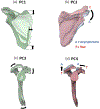Three-dimensional scapular morphology is associated with rotator cuff tears and alters the abduction moment arm of the supraspinatus
- PMID: 32580097
- PMCID: PMC8161464
- DOI: 10.1016/j.clinbiomech.2020.105091
Three-dimensional scapular morphology is associated with rotator cuff tears and alters the abduction moment arm of the supraspinatus
Abstract
Background: Numerous studies have reported an association between rotator cuff injury and two-dimensional measures of scapular morphology. However, the mechanical underpinnings explaining how these shape features affect glenohumeral joint function and lead to injury are poorly understood. We hypothesized that three-dimensional features of scapular morphology differentiate asymptomatic shoulders from those with rotator cuff tears, and that these features would alter the mechanical advantage of the supraspinatus.
Methods: Twenty-four individuals with supraspinatus tears and twenty-seven age-matched controls were recruited. A statistical shape analysis identified scapular features distinguishing symptomatic patients from asymptomatic controls. We examined the effect of injury-associated morphology on mechanics by developing a morphable model driven by six degree-of-freedom biplanar videoradiography data. We used the model to simulate abduction for a range of shapes and computed the supraspinatus moment arm.
Findings: Rotator cuff injury was associated with a cranial orientation of the glenoid and scapular spine (P = .011, d = 0.75) and/or decreased subacromial space (P = .001, d = 0.94). The shape analysis also identified previously undocumented features associated with superior inclination and subacromial narrowing. In our computational model, warping the scapula from a cranial to a lateral orientation increased the supraspinatus moment arm at 20° of abduction and decreased the moment arm at 160° of abduction.
Interpretations: Three-dimensional analysis of scapular morphology indicates a stronger relationship between morphology and cuff tears than two-dimensional measures. Insight into how morphological features affect rotator cuff mechanics may improve patient-specific strategies for prevention and treatment of cuff tears.
Keywords: Biplanar videoradiography; Imaging - computed tomography; Musculoskeletal modeling; Rotator cuff; Shoulder; Statistical shape modeling.
Copyright © 2020 Elsevier Ltd. All rights reserved.
Conflict of interest statement
Declaration of Competing Interest None.
Figures







References
-
- Adams CR, Baldwin MA, Laz PJ, Rullkoetter PJ, Langenderfer JE, 2007. Effects of rotator cuff tears on muscle moment arms: a computational study. J. Biomech 40, 3373–3380. - PubMed
-
- Aizawa J, et al., 2010. Three-dimensional motion of the upper extremity joints during various activities of daily living. J. Biomech 43, 2915–2922. - PubMed

